
Solution Overview
The CQ-3270EE® connectivity
solution combines numerous features with an advanced interface to provide users
with 3270 interactive mainframe connectivity over existing IP networks. The
transmission of SNA data over IP networks is accomplished through IBM’s®
advanced Enterprise Extender technology.
The Move to Enterprise Extender
 IBM Front End Processors (FEPs), such as the 3745 and 3746 Controllers, form
the backbone of many mission critical SNA networks by allowing remote SNA
clients to connect to mainframe computers. These FEPs were withdrawn from
marketing by IBM effective September 27, 2002. Since that date, only used
FEP products and features have been available. Since IBM’s announcement,
networks that are based on these controllers have begun the realization that
these FEPs are no longer supported and another SNA type connectivity solution is
necessary.
IBM Front End Processors (FEPs), such as the 3745 and 3746 Controllers, form
the backbone of many mission critical SNA networks by allowing remote SNA
clients to connect to mainframe computers. These FEPs were withdrawn from
marketing by IBM effective September 27, 2002. Since that date, only used
FEP products and features have been available. Since IBM’s announcement,
networks that are based on these controllers have begun the realization that
these FEPs are no longer supported and another SNA type connectivity solution is
necessary.
IBM states that the reason that the controllers were withdrawn from marketing
is the success of IP in corporate networks. In the IBM Announcement Letter
dated February 26, 2002, IBM stated that the "explosive growth of the Internet
and TCP/IP traffic have resulted in a severe decline in the demand for new 3745
and 3746 Communication Controllers." In fact, it is widely accepted that
IP is the strategic networking protocol of the future. IP has been around
since 1969 so it is well established and also offers features such as
scalability, redundancy, resiliency, openness, adaptability, and manageability.
As a transition for SNA users, IBM developed an IP transport technology
called Enterprise Extender (EE). Enterprise Extender allows remote SNA
clients to continue to communicate with mainframes over existing IP networks in
much the same way as they do today.
SNA Connectivity over IP Networks
The IBM Announcement of FEPs being withdrawn from marketing is important
because many SNA networks rely upon IBM’s FEPs to connect SNA traffic between
remote clients and corporate mainframes. The CQ-3270EE
solution utilizes the EE technology and allows remote SNA clients access to
corporate mainframe data centers over existing IP connections.
Through CQ-3270EE, the applications and data that remote
clients have used throughout the years can now be accessed over IP networks.
CQ-3270EE users will find this new technology as reliable,
scalable, and easy to use as SNA and because CQ-3270EE uses
standard IP technology, the solution does not require new client hardware or
software to be installed. In fact, certain client-side hardware such as
dial-up modems, DLSw routers, Token Ring cards, and serial adapter cards are
eliminated altogether.
For more technical information, use this link for a Technical Overview of
Enterprise Extender.
CQ-3270EE Features
-
Seamless Transition for CQ-3270 Clients.
For current CQ-3270 clients, the transition to the
CQ-3270EE solution is seamless as the user-interface is identical for
both connectivity solutions. The similarities between the connectivity
solutions eliminate the need for any additional training programs and
application changes that might have occurred had the user-interface
significantly changed.
-
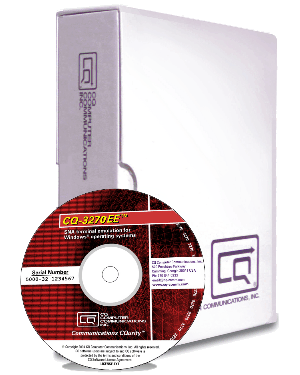 Interactive
GUI Interface. The user-friendly interface makes
installation, configuration, and use of CQ-3270EE simple and
easy to understand. Interface components such as drop-down menus,
customizable toolbars, clearly identified buttons, and context-sensitive help
can be found throughout the solution.
Interactive
GUI Interface. The user-friendly interface makes
installation, configuration, and use of CQ-3270EE simple and
easy to understand. Interface components such as drop-down menus,
customizable toolbars, clearly identified buttons, and context-sensitive help
can be found throughout the solution.
-
Customizable Features. The
customizable toolbar and floating SmartKey Pad allow users convenient and
quick access to common 3270 terminal commands that may not be easily accessible
from a standard PC keyboard. For example, most PC keyboards do not contain
keys to access 3270 terminal commands such as Clear, Reset, and PA1. The
buttons located on the toolbar and SmartKey Pad perform any commands,
including common 3270 terminal commands, and can be easily customized to fit
session specific applications. Users can also customize the color, font,
and cursor attributes for each session through CQ’s simple display customization
procedures. Features include over 16 million background and foreground
colors, automatic font sizing that automatically resizes fonts depending on the
size of the Interface screen, numerous fonts to choose from, and special cursor
features.
- Configurator. CQ’s
Configurator program allows users to quickly and easily set communication
options. Most of these options are set from the Quick Configuration
screen. EE specific options include the CP Name, DLUS Name,
and Destination IP address. Users can generally set the necessary
options from this screen within a matter of minutes.
The CQ-3270EE solution also allows for the configuration of a
backup DLUS Name and Destination IP address within the
Configurator program in the event that session establishment fails with
the primary option settings.
- Interface Screen. The
Interface screen’s interactive console area is where CQ’s 3270 terminal
emulation occurs. Interactive commands and messages are entered and
received through the console area. The type of session, either an LU2
display or an LU1/LU3 printer, is determined by the mainframe when the session
is bound to the mainframe. A separate Interface screen appears
for each session that you create.
- Security Features.
CQ-3270EE is equipped with numerous security features. Certain
areas of the program are password protected. The configuration data is
decrypted dependent upon the proper entry of the correct password.
Dial-back security is also supported. Also, for the ultimate in secure
communications, the Triple Data Encryption Standard (Triple
DES) security option is available as an option at an additional
cost.
- Printing Features.
CQ-3270EE supports any laser printer that is supported by the Windows
operating system. Customizable print features such as the number of
lines and columns and page orientation can easily be setup through the
solution. CQ-3270EE also supports the Windows operating
system print spooler so the user can print multiple jobs. Up to eight
concurrent printers are also supported by the solution. The solution
also supports older legacy printers for uses that require raw line prints.
For the ultimate in printer features and compatibility, the
CQ-Print Administrator™
productivity solution provides an efficient way to manage and print text based
files according to your specific print layout requirements and specifications.
The solution is useful for large recurring print jobs that require pre-set
file formatting options and also allows you to configure and save print
Layouts for unattended print jobs that you schedule through other programs,
including CQ-3270EE. Through these print Layouts, you can
also include customizable headers, footers, and banner pages that allow you to
separate and identify print jobs according to your specific requirements.
- CQ Diagnostics. CQ-3270EE
provides accessible communications logging features through its audit and
trace options. These features are used for tracking the user’s data
transfers and include time stamps, file send and receive information, and file
size information.
- CQ Keyboard Remapper. IBM’s
Standard and Enhanced PC keyboards are supported through CQ’s graphical
remapping utility program. The user can easily assign key definitions to
fit specific application requirements.
- Scripting and Scheduling for Unattended
Operation. CQ’s scripting language allows automated and
unattended CQ-3270EE host site communications through customized
scripts and scheduling features. Unattended automation facilities make
host site communications more cost effective than normal attended operation.
- Multiple Simultaneous LU Devices.
CQ’s 3270 solution provides emulation of multiple concurrent Logical
Unit (LU) devices. These include emulation of LU2 (IBM 3278/3279 Model
2, 3, 4, or 5 display) and LU1/LU3 (IBM 3287 host printer) type devices.
- IND$FILE File Transfers.
CQ-3270EE implements IBM’s IND$FILE specifications for sending and
receiving files. Files can be transferred in either text or binary
formats. The solution supports multiple background, simultaneous
bi-directional file transfers that substantially increase data throughput.
-
CQ Access Point
Agreement (CQ’s Annual License Activation and Software Maintenance
Program). CQ recognizes the importance of providing our customers with
access to comprehensive technical services and support. CQ also feels that
access to product upgrades and updates is an integral part of an
organization’s overall software deployment strategy. With this in mind, CQ
provides the CQ Access Point agreement to its customers. With each
license acquisition, you receive annual license activation as well as access
to the product upgrade and technical support features of Software Maintenance.
Sample Screen Shots
CQ provides our web page visitors with a quick look at several sample
CQ-3270EE screens.
CQ Configurator Screen
This screen displays the settings required by most users to complete
configuration.
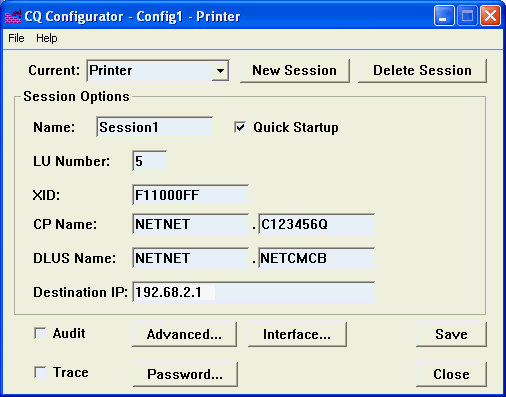
Interface Screen
The Interface screen appears in Interactive mode when you are
connected with the host.

Receive Data Screen
From this screen, you can change the settings associated with receiving print data
from the host.
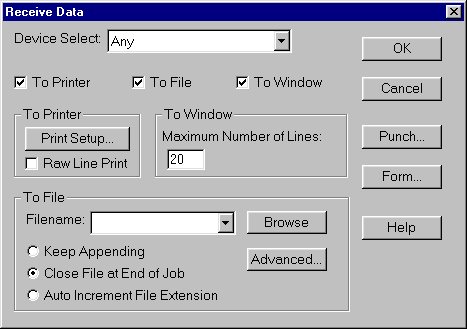
Receive Data - Form Options Screen
From this screen, you can change the settings associated with receiving form
data.
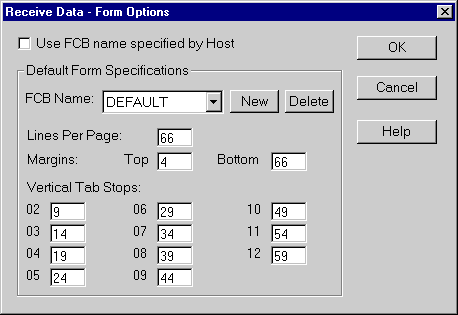
CQ Script Screen
From this screen, you can view a CQ script as it runs.
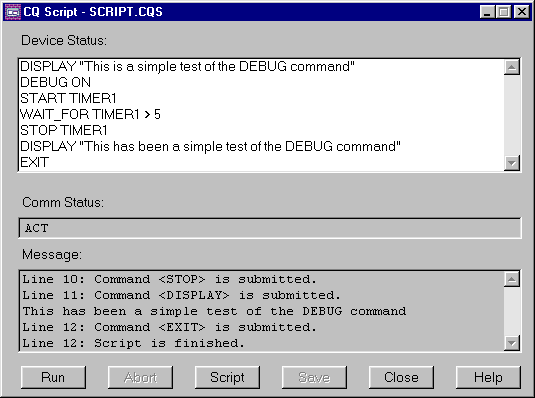
Customize Toolbar Screen
From this screen, you can customize the toolbar that appears within the
Emulator screen by adding, editing, or deleting toolbar buttons.

Specifications
Workstation/Server Requirements
- Processor. An Intel Pentium microprocessor is recommended,
although other compatible microprocessors such as the Celeron and AMD K6/Athlon/Duron
family of microprocessors are also supported.
- Drive Space. A minimum of 200 MB of fixed drive space is required.
- Operating System. Most Microsoft Windows operating systems
are supported.
- Memory. A minimum of 128 MB of memory is required, although at
least 256 MB of memory is recommended.
- TCP/IP Protocol. The TCP/IP protocol (i.e., Internet Protocol)
should be bound to the system’s network card.
- Other Requirements. CQ may indicate other hardware and software
requirements to you at the time of purchase.
Contact CQ for additional
information.
Host End Requirements
- The host computer must be an IBM mainframe or compatible
host with IBM’s Enterprise Extender support.
For assistance in determining if your host site supports Enterprise Extender,
you can contact your host site personnel or contact CQ and we can assist in
determining if this feature is a part of your host site’s mainframe
architecture.
- For Triple DES
security clients, the host computer must also have the Triple DES feature
installed and enabled.
 Top of Page
Top of Page


 IBM Front End Processors (FEPs), such as the 3745 and 3746 Controllers, form
the backbone of many mission critical SNA networks by allowing remote SNA
clients to connect to mainframe computers. These FEPs were withdrawn from
marketing by IBM effective September 27, 2002. Since that date, only used
FEP products and features have been available. Since IBM’s announcement,
networks that are based on these controllers have begun the realization that
these FEPs are no longer supported and another SNA type connectivity solution is
necessary.
IBM Front End Processors (FEPs), such as the 3745 and 3746 Controllers, form
the backbone of many mission critical SNA networks by allowing remote SNA
clients to connect to mainframe computers. These FEPs were withdrawn from
marketing by IBM effective September 27, 2002. Since that date, only used
FEP products and features have been available. Since IBM’s announcement,
networks that are based on these controllers have begun the realization that
these FEPs are no longer supported and another SNA type connectivity solution is
necessary. Interactive
GUI Interface. The user-friendly interface makes
installation, configuration, and use of CQ-3270EE simple and
easy to understand. Interface components such as drop-down menus,
customizable toolbars, clearly identified buttons, and context-sensitive help
can be found throughout the solution.
Interactive
GUI Interface. The user-friendly interface makes
installation, configuration, and use of CQ-3270EE simple and
easy to understand. Interface components such as drop-down menus,
customizable toolbars, clearly identified buttons, and context-sensitive help
can be found throughout the solution.




